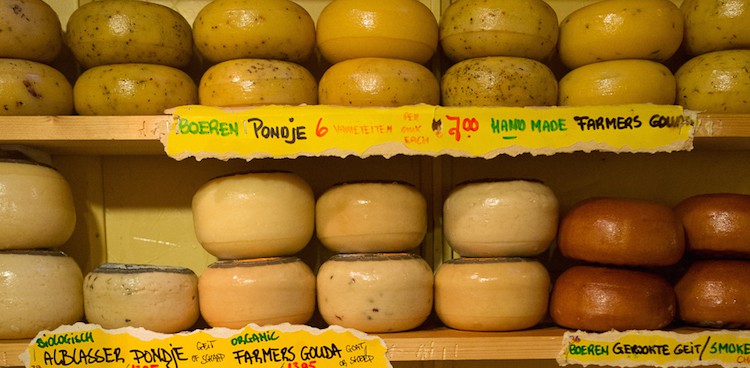
Gouda, that delectable Dutch cheese comes in varieties that range from soft, pale, and mild to crunchy, caramel-colored, and rich. Plus, in addition to traditional Gouda you can also find the increasingly popular goat Gouda as well as gouda flavored with everything from fenugreek to pesto. What holds this family of cheeses together and where did they originate?
Many Variations
Gouda comes in many ages, flavors, and sizes. it can be raw or pasteurized and can range in size from 1- to 176-pound wheels. The rind of a Gouda may be natural, coated, or waxed, and the cheese may be plain or flavored with herbs or spices. So what do all Goudas have in common? Their shape: All Goudas are made as flattened wheels.
It’s also true that most Gouda comes from Holland (it’s the most commonly produced cheese in the Netherlands). While the name Gouda isn’t protected or restricted the way that Camembert or Gruyere are, most cheese authorities agree that “true” Gouda comes from Holland and is made with cow’s milk. However, that doesn’t mean that Gouda produced in the US and elsewhere or made with goat’s or sheep’s milk can’t be delicious.
Noord-Hollandse Oplegkaas is the only Gouda with a PDO (Protected Designation of Origin). This cheese is made with pasteurized cow’s milk and aged a minimum of two years, at which point it has developed the caramel and butterscotch flavors and crunchy crystals that characterize aged Gouda.
A Place of Commerce
Many cheeses garner their names from the towns and counties where they were traditionally made. Gouda, which can trace its name back to at least 1184, takes its name from the Dutch city of Gouda. However, unlike many cheeses, the name comes not because it was made there, but due to the town’s bustling cheese trade. In fact, the city of Gouda boasted a complete monopoly on Gouda cheese. Farmers throughout Holland journeyed to the city to sell their cheese on market days. Today cheesemakers still congregate in the square to have their product weighed, tasted, and priced. Although many Americans pronounce the name of the cheese and city GOO-duh, the correct pronunciation is HOW-duh. If you’re talking to a cheesemonger stateside, you’re probably fine sticking with the Americanized version, but should be lucky enough to try the cheese in its place of origin it’s good to know.
Better with Age
Because of Gouda’s unique make process, aging brings out different flavors in this cheese than in many others. The curds of Gouda are washed with hot water before pressing, which removes some of the lactose. This leaves less lactose in the aging cheese for lactic bacterium to convert into lactic acid. The result is a sweeter cheese that doesn’t become tart or “sharp” as it ages. While young Gouda is only aged for a few months, most Goudas are aged for years, allowing their flavors to develop and deepen. Young Gouda, aged between 2 and 6 months, ranges from semi-soft to semi-firm and has a mild, creamy pale-yellow paste. Aged Gouda can be five years old or more, These Goudas are very hard and break into shards when cut, and have rich, orange-colored paste. Aged gouda also sports tyrosine, which are those crystalline, crispy pieces full of satisfyingly meaty amino acids.
Aged Gouda is one of the most complex cheeses containing a medley of flavors. Upon taking a nibble, you might taste toasted nuts, butterscotch, vanilla, and even bourbon. High-quality Gouda exhibits the perfect balance of salty and sweet, meltiness and crunch.
Pairing Suggestions
Pairings for Gouda depend strongly on the age and milk type of the cheese.
- Try goat’s milk Gouda in a Dutch Puff Pancake
- Use a Gouda flavored with cumin or fenugreek in an Autumn Cobb Salad
- While we love eating aged Gouda on its own with fresh fruit and nuts, you can also cook it into Walnut Biscotti
- Pair aged Gouda with a sour beer or dry sparkling cider that will balance out the caramel notes






HI! Some of your articles call the crystals in cheese tyrosine, but my understanding is that they are calcium lactate. What’s the deal?